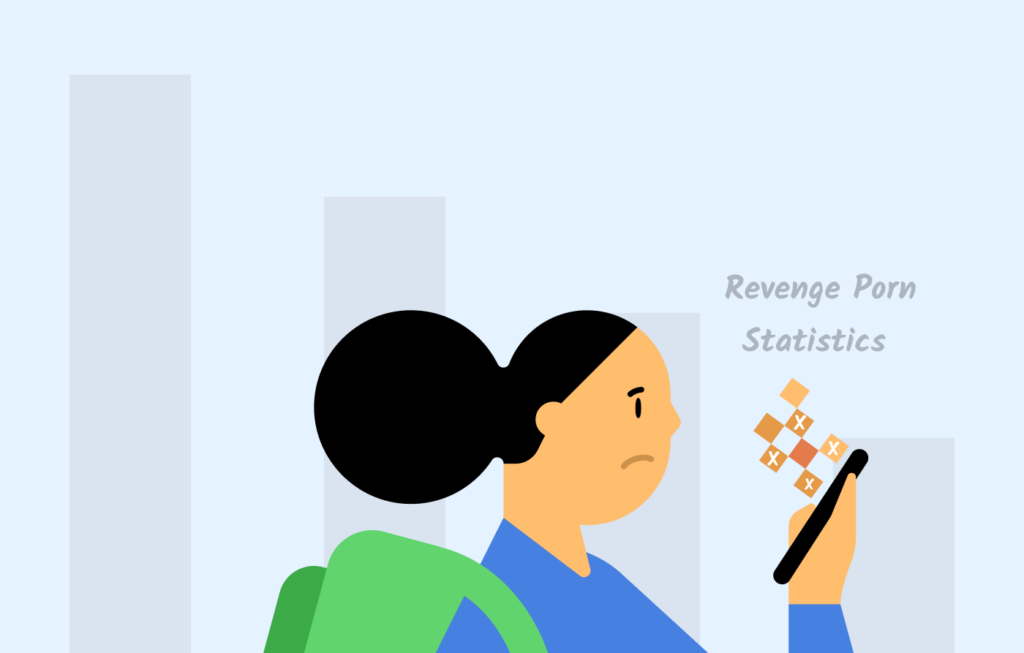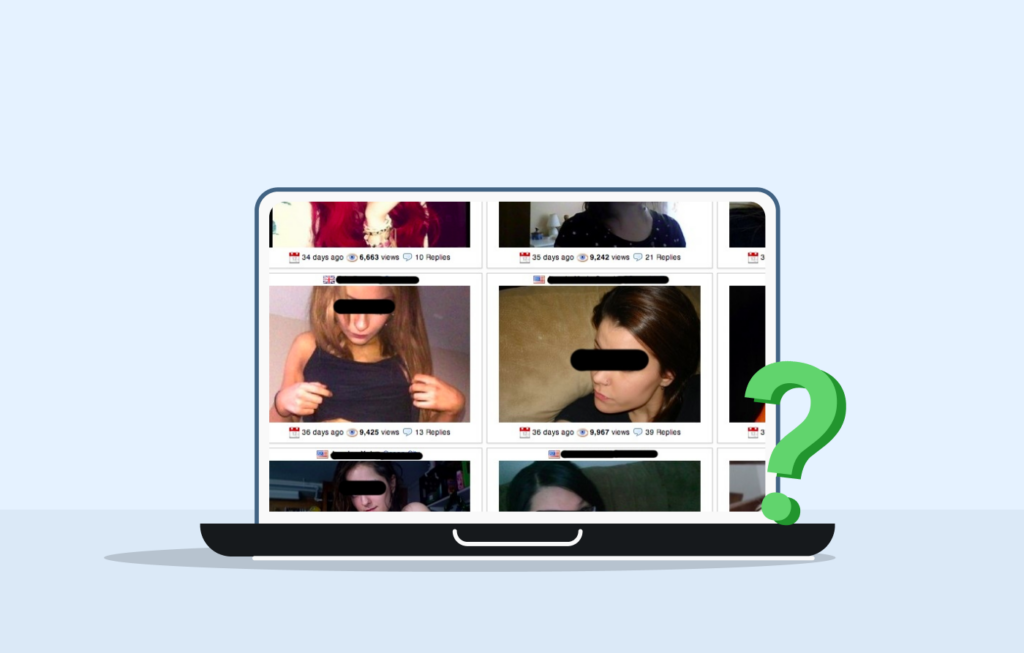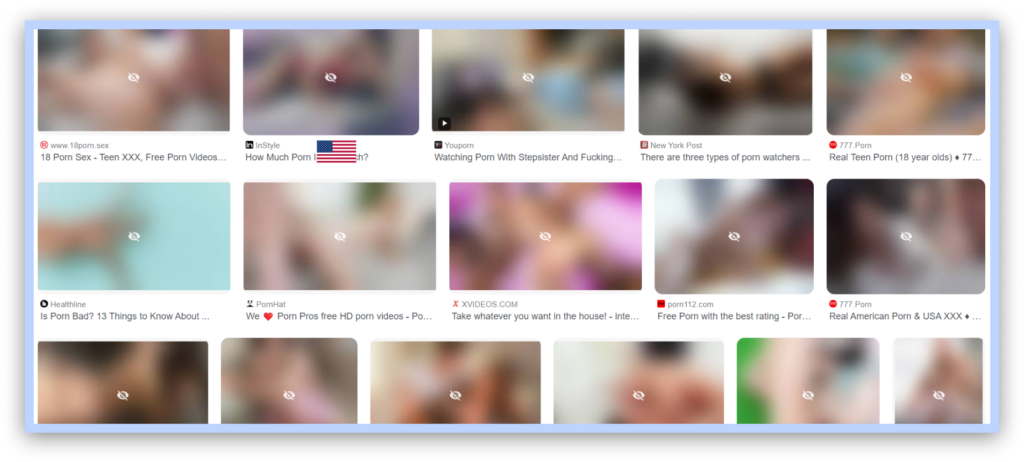-
Revenge porn is a widespread issue, with studies showing a significant percentage of people affected.
-
This issue is not limited to disgruntled ex-partners who want revenge, as people commonly assume; it is widely spread across other people, too.
-
Legal protection, strict laws, increased awareness, and support services are necessary to fight revenge porn and protect victims.

The internet allows us to connect with people around the world, but it has also exposed us to a disturbing issue that has left many people vulnerable and violated–revenge pornography. This cybercrime involves a person sharing intimate pictures or videos without the owner’s consent. They do this often with the intent to hurt, shame, or humiliate the person displayed.
While revenge porn is common in our society, it’s still grossly underreported and misunderstood. This lack of awareness among lawmakers and the general public has helped to perpetuate this crime, leaving victims feeling alienated and helpless. Therefore, we have outlined revenge porn statistics to give you an insight into this issue. So, let’s read along and discuss these stats in detail.
Top revenge porn statistics – Quick list
- In 2019, the police in Wales and England recorded 2330 cases of revenge pornography.
- According to a Brookings Institution study, more than 80% of ‘revenge porn did not appear to involve a resentful ex-partner.
- According to the Australian Office of the eSafety Commissioner, one in ten Australian adults had a victimizing picture taken without giving consent.
- In a South Korean study of 2,000 teenage respondents, over 16% admitted to engaging in ‘digital sex crimes,’ which is sharing sexual content without consent.
- 32.3% of change.org users in New Zealand reported experiencing sexual harassment online, mostly through revenge pornography.
- According to the Cyber Civil Rights Initiative, as of 2018, 41 states in the US have laws expressly addressing revenge pornography.
- A 2017 survey shows that 9% of the UK public have taken obscene images and threatened to reveal them.
- According to the BBC, only 3% of image-based sexual abuse cases result in a conviction in the United Kingdom.
- Thorn conducted a poll in 2019 and found that roughly 7% of respondents admitted to posting sexual pictures of others online without their consent.
- In 2020, over 24% of all revenge porn victims in South Africa were under the age of 18.
- An ISPCC study stated that teenagers aged 18 and 19 were responsible for the majority of the reported cases of revenge porn in Ireland (22% and 20%, respectively).
- According to Amanda Lenhart’s research, 67% of revenge porn victims face threats from the sharing of explicit pictures.
- A research conducted by Durham Law School shows that 30% of revenge porn defendants have had past convictions or caution.
- According to a survey by the Cyber Civil Rights Initiative, 51.7% of nonconsensual porn victims had attempted suicide.
- A survey by the Data Society and the Center of Innovative Public Health Research shows that roughly 4% of worldwide internet users have been revenge porn victims.
- According to cybersmile.org, 38% of men and 35% of women texted their partners explicit pictures of themselves.
- Cybersmile.org reports that 45% of women and 57% of men reported receiving explicit images from their partners.
- A survey from Cybersmile.org shows that 94% of Americans believe their intimate pictures are safe with their present partners.
- 10% of ex-partners have promised to expose naked pictures of their former partners, and 60% of those who make such threats follow through.
- A survey from the Cyber Civil Rights Initiative shows that 83% of revenge porn victims admitted to sharing nude pictures and videos of themselves with others.
- According to the Cyber Civil Rights Initiative, 13% reported cases of losing a significant other as a victim of revenge porn.
- 34% of revenge porn victims have said that the situation has jeopardized their relationships with family.
- 42% of victims have sought out psychological services due to revenge porn.
- The Cyber Civil Rights Initiative reports that 37% of revenge porn victims were teased by other people.
- A survey from the Cyber Civil Rights Initiative shows that 49% of victims reported being harassed or stalked online by others who saw their pictures/videos.
What is revenge porn?

Revenge porn or image-based sexual abuse (IBSA) involves sharing someone’s intimate or sexually explicit images or videos without their consent. This type of cybercrime is usually carried out by a former partner to humiliate, retaliate against, or intimidate an ex after a breakup. However, it can also occur through hacking, coercion, or other means.
While people have different motivations for this act, it causes trauma for the victims, often making them depressed and anxious. Revenge porn also causes online and offline harassment, reputational damage, and issues like getting fired from jobs. Many states prohibit revenge pornography, but it remains legal in certain areas, leaving victims with few options.
Revenge porn statistics: Detailed list

In 2019, the police in Wales and England recorded 2330 cases of revenge pornography
From this 2019 report, the police in Wales and England recorded 2,330 cases of revenge porn, which was a significant increase from previous years. This data highlights the growing prevalence of this form of image-based sexual abuse in the United Kingdom.
While it is illegal under the Revenge Porn Helpline Act of 2015, the number of reported incidents continues to rise, making additional public awareness and stronger enforcement measures necessary. Consequently, the police have taken steps to effectively investigate and prosecute revenge porn cases, including training, victim support, and partnerships with organizations like the Internet Watch Foundation (IWF).
According to a Brookings Institution study, more than 80% of revenge porn cases did not appear to involve a resentful ex-partner
When you look at this statistic, it is clear that it defies the popular narrative. It implies that the problem may be rooted in more than just sad breakups, but in a societal and cultural issue that is broader. As such, people could share explicit content in different situations like hacking incidents, coercion, or distribution for profit or entertainment.
So, if more than 80% of revenge porn does not involve spiteful former partners, we may have to adopt a different perception. We need to understand the motivations and conditions behind the non-consensual sharing of intimate pictures and videos to fight this abuse.
According to the Australian Office of the eSafety Commissioner, one in ten Australian adults had a victimizing picture taken without giving consent
This concerning survey by the Australian Office of the eSafety Commissioner shows that adults in Australia have had to deal with having their personal or naked pictures taken without consent. From the number of victims (one in ten), there is a high number of image-based abuse incidents in the country.
This case shows a serious invasion of privacy and personal dignity. This is why adopting strong measures to safeguard people from this type of technology-facilitated exploitation is necessary. Additionally, raising awareness about the legal and ethical implications of non-consensual image capturing and sharing will go a long way.
In a South Korean study of 2,000 teenage respondents, almost 16% admitted to engaging in ‘digital sex crimes,’ which is sharing sexual content without consent
The revelation that nearly 16% of teenagers said that they engaged in such activities that involve a violation of privacy and consent is deeply concerning. It shows the urgent need for educational activities and awareness campaigns to address this issue among minors.
To prevent teens from normalizing and perpetuating these harmful practices, adopt effective actions from an early age. These measures will promote a culture of respect, consent, and ethical digital citizenship.
32.3% of change.org users in New Zealand reported experiencing sexual harassment online, mostly through revenge pornography
With this percentage of people experiencing online sexual harassment, it is obvious that revenge porn affects people across several platforms and social media networks. Unfortunately, the anonymity and ease of sharing content online have fostered the spread of this harmful behavior. In addition, petitions in New Zealand have mentioned over 400,000 reported incidents of bullying and sexual harassment.
Whether people are sexually harassed offline or online, it does not change the fact that it causes severe emotional and psychological pain in victims. So, we must address sexual harassment, particularly revenge porn.
According to the Cyber Civil Rights Initiative, as of 2018, 41 states in the US have laws expressly addressing revenge pornography
The purpose of these laws is to fight revenge porn while offering legal aid to victims of this digital abuse. This legal action by these 41 states shows how important it is to protect victims from this form of online exploitation. Consequently, the laws can hold offenders accountable for their actions.
These state laws also allow the public to criminalize the circulation of nonconsensual porn. The laws also safeguard people from emotional and reputational harm. These regulations show a nationwide effort to confront and avoid the damaging effects of online image-based sexual exploitation.
A 2017 survey shows that 9% of the UK public has taken obscene images and threatened to reveal them
Revenge porn is widespread, and the UK is not left out. This 2017 statistic revealed the need to put measures in place to avoid any negative emotional and psychological implications for victims. Researchers have found that the events in the United Kingdom nearly doubled after only two years, just like other revenge porn cases in other countries.
Since this issue still exists, the UK and other countries should create effective policies for preventing and tackling revenge porn. These policies will ensure that victims receive the help and protection they need to recover.
According to the BBC, only 3% of image-based sexual abuse cases result in a conviction in the United Kingdom
This BBC report is sad because this low figure shows that a lot of online sexual abusers roam freely. It highlights the barriers victims face when seeking justice and keeping offenders accountable. When there are no convictions, people who have to deal with the implications of revenge porn do not get closure. It also creates an environment where offenders are bold, and victims are scared to make reports.
This situation should not be encouraged, and so conviction rates should be raised in the United Kingdom and the world at large to prevent image-based sexual abuse. This act will also ensure that survivors will receive the justice they deserve.
Thorn conducted a poll in 2019 and found that roughly 7% of respondents admitted to posting sexual pictures of others online without their consent
People post intimate pictures and videos of others online without their consent for different reasons. However, what triggers this action is the need for people to humiliate, control, or seek revenge against their victims. As such, this 2019 poll result by Thorn shows the lack of respect for people’s privacy or a sense of entitlement towards them.
Furthermore, people post sexual pictures of people online without their consent for financial gain. Regardless of the reasons behind it, revenge porn is disturbing and should not be normalized. This act causes emotional and psychological damage to victims.
In 2020, over 24% of all revenge porn victims in South Africa were under the age of 18
This high percentage is an indication that a significant amount of revenge porn victims are minors. With the harmful impact of this issue, it shows how vulnerable young people are on the internet. Most adolescents do not understand the potential consequences of sharing nude pictures or videos, making it easy for people to exploit them online.
If the emotional and psychological toll on adult victims is a lot, imagine what it would look like for teenagers. Revenge porn has turned many underaged victims into anxious, isolated, and depressed people. For this reason, detailed digital education, legal protection, and support services to protect minors is a huge need.
An ISPCC study stated that teenagers aged 18 and 19 were responsible for the majority of the reported cases of revenge porn in Ireland (22% and 20%, respectively)
Similar to the stat above, teens in Ireland have also experimented with revenge porn. This bothersome study shows how much older teens involve themselves in these incidents. In addition, it shows that there is minimal control over the online behavior of teenagers, which leads to the misuse of digital platforms.
While revenge porn clearly shows disregard for people’s privacy, this issue should be tackled head-on so that teens understand the gravity of this act. As a result, laws should be modernized to protect victims of intimate image sharing specifically. In addition, there should be programs to educate teens to foster a culture of respect, consent, and online citizenship.
According to Amanda Lenhart’s research, 67% of revenge porn victims face threats from the sharing of explicit pictures
Amanda Lenhart’s study reveals a worrying fact: 67% of victims are threatened with the release of their private pictures. As a result of this stat, it is clear that most victims experience intimidation, fear, and anxiety from being threatened by revenge porn.
This invasion of privacy contributes to the emotional distress that these victims face. In addition, it highlights the urgent need for stronger legal measures, better victim care, and a societal shift to fight these revenge porn threats.
A research conducted by Durham Law School shows that 30% of revenge porn defendants have had past convictions or caution
This Durham Law School stat shows a pattern of repetition among offenders. Since there is a significant percentage of defendants with prior convictions, it suggests that legal consequences may not prevent them from engaging in this harmful behavior.
For this reason, firms should take steps to address this issue. A multifaceted strategy that includes effective rehab programs, enhanced community awareness, and stronger legal frameworks may be the key to holding these abusers accountable.
According to a survey by the Cyber Civil Rights Initiative, 51.7% of nonconsensual porn victims had attempted suicide
The disturbing data from the Cyber Civil Rights Initiative shows how serious and dangerous the impact of revenge porn can be. As such, it is a reminder that this violation causes significant emotional and mental suffering, which prompts victims to attempt suicide. This is why we need more support services and legal protections to address this issue and prevent more victims from harming themselves.
A survey by the Data Society and the Center of Innovative Public Health Research shows that roughly 4% of worldwide internet users have been revenge porn victims
According to their findings, approximately 4% of internet users worldwide have been victims of revenge porn, involving sharing or posting of intimate or sexually explicit images or videos without consent. This percentage translates to millions of people who remained as victims of digital abuse.
As a result of this stat, we can see the widespread nature of revenge porn spans across different countries and affects people from all backgrounds and ethnicities. Since sharing content online is easy, people risk becoming victims of this issue. Moreover, the lack of understanding and legal safeguards in some areas has aided its spread.
According to cybersmile.org, 38% of men and 35% of women texted their partners explicit pictures of themselves
With this stat, it is clear that sharing intimate content in romantic relationships is common. Many people feel comfortable with this act due to the feeling of privacy they get from direct messaging. However, while voluntarily sharing intimate pictures and videos is not necessarily harmful, there are risks in them; case in point: revenge porn.
Once these pictures and videos get into the hands of others, even within the context of a trustworthy relationship, they may be spread without consent. This is why people should be cautious and think about the potential implications before engaging in such actions, especially in the context of a seemingly safe relationship.
Cybersmile.org reports that 45% of women and 57% of men reported receiving explicit images from their partners
Just like the stat above that shows how people send sexual pictures to their partners, these percentages of men and women have also received them. Since people are different, there would be people who will prioritize respect for privacy and delete these pictures or keep them safely hidden even after a bad breakup.
However, others may see it as an opportunity to get revenge, especially if they feel slighted. As a result, the person who receives the images becomes an offender, and the one who sends them becomes a victim.
A survey from Cybersmile.org shows that 94% of Americans believe their intimate pictures are safe with their present partners
This survey suggests that many people assume that their partners will respect their privacy and not share intimate images without consent. While it is not wrong for people to have so much trust in romantic relationships, sharing sexual images could be risky, especially as revenge porn cases often involve ex-partners.
Consequently, it is a good idea to set boundaries in a relationship and discuss any expectations regarding intimate images to make sure that both parties are on the same page. In addition, education and awareness about the risks associated with sharing intimate content is also necessary.
10% of ex-partners have promised to expose naked pictures of their former partners, and 60% of those who make such threats follow through
From this report, we see that 10% of people make threats to exploit the vulnerability and trust of people whose intimate pictures they have in their possession. Another alarming fact is that 60% of people who make these threats often carry them out.
When offenders carry out their threats, it often results in major implications for the victims, including social humiliation, emotional distress, and also a negative impact on their careers. For this reason, we need better legal protections to fight revenge porn and support victims.
A survey from the Cyber Civil Rights Initiative shows that 83% of revenge porn victims admitted to sharing nude pictures and videos of themselves with others
This statistic shows how pervasive digital intimacy is in modern relationships, prompting people to share their nudes. However, when people share these images, they do so because they trust the recipient.
However, it can be devastating when the receiver shares these images without the sender’s consent. This is why there is a need for increased education on digital privacy and consent, including the significance of legal frameworks to protect revenge porn victims.
According to the Cyber Civil Rights Initiative, 13% reported losing a significant other as a victim of revenge porn
This stat highlights the severe personal consequences of revenge porn. This violation goes beyond mental pain and public humiliation to have a heartbreaking impact on close relationships. When a relationship ends because of this issue, it could increase the trauma of the victim.
For this reason, support networks should be in place to address both the immediate and long-term consequences of revenge porn. From this research, it is necessary for people to be empathetic towards victims, especially their loved ones, to reduce the effects of this issue in their lives.
34% of revenge porn victims have said that the situation has jeopardized their relationships with family
Similar to losing a partner from revenge porn, people also lose their relationships with their family members as a result of revenge porn. While this issue is out of the victim’s hands, they may face judgment from family members who struggle to understand the situation.
This strain on family relationships can isolate victims further, making it necessary for there to be family education on digital privacy. In addition, there should be awareness about support for affected people to help them navigate this situation.
42% of victims have sought out psychological services due to revenge porn
Releasing explicit pictures without the victim’s consent often causes mental issues like anxiety, trust issues, and depression, which may require professional care. Consequently, revenge porn statistics show the need for accessible mental health resources and support networks for revenge porn victims.
It also advocates for improved social awareness, getting treatment without stigma, and encouraging psychological services to better the health of victims. These measures will increase a victim’s sense of security and well-being after this traumatic experience,
The Cyber Civil Rights Initiative reports that 37% of revenge porn victims were teased by other people
This statistic shows the humiliation that victims experience, even if they were not the ones who performed the unethical act of sharing private information. As a result, the fear of mocking, bullied, or shunned by peers can make victims feel ashamed, alone, and hesitant to seek help.
Due to this influence on victims’ mental health, it is important to fight the victim-blaming attitudes that enable this type of abuse to continue. By cultivating a culture of empathy, support, and accountability, it can reduce the social consequences of revenge porn.
A survey from the Cyber Civil Rights Initiative shows that 49% of victims reported getting harassed or stalked online by others who saw their pictures/videos
This percentage points out the emotional damage that victims of revenge pornography experience, as they get harassed by strangers who have accessed their private content.
For this reason, legal protection and support services for victims of revenge pornography are necessary. In addition, awareness of the dire consequences of this type of online abuse.
Law enforcement action against intimate image abuse and revenge porn

While the aftermath of revenge porn often leaves a bitter taste, some authorities have addressed this concern. For instance, there’s a Jane/John Doe law in California that allows victims to be anonymous if the court considers the need to protect their privacy.
However, some factors prevent law authorities and courts from investigating and prosecuting revenge pornography cases. A few of them are:
- Criminal Justice personnel may not give priority to revenge porn cases when they’re not aware of the facts or psychological and emotional harm victims may suffer.
- Civil and criminal cases can be challenging to investigate and resolve because most digital platforms are anonymous and gathering evidence is not always straightforward. This challenge often heightens when the legal practice is not technologically advanced.
- Not all criminal justice practitioners have expert knowledge of the specific rules or language that govern revenge porn. In addition, the appropriate resources to investigate a case, both legally and otherwise, may not be available.
- Social media channels have implemented their unique regulations to identify and respond to issues like revenge porn. These policies may preempt criminal justice procedures and practices.
How to tackle revenge porn with more effective legal frameworks?

Here are some ways to tackle revenge porn with more effective legal frameworks, according to experts:
- Enlightening people about all forms of intimate image abuse.
- Mitigating the harm caused by IIA and empowering victims to respond to victimization.
- Enhancing criminal justice policies and processes to combat sexual image abuse.
From this perspective, certain actions could improve the legal processes related to revenge pornography and encourage victims to speak up. For one, updated statuses that clearly address IIA (Intimate Image Abuse) and its damages while emphasizing the gravity of the abuse, as well as clear, stringent sentences, is a step in the right direction.
In addition, there should be an extensive knowledge source focusing on the technological aspects of revenge porn and the susceptibility of victims. Moreover, training staff members to be able to identify, collect, and handle digital evidence and providing adequate tools to do so will be helpful.
Another action that could have an impact is reducing any legal limitations that may deter a lot of victims from speaking out due to humiliation. Furthermore, civil and criminal advice should be available to victims so they can choose which action plan is best for them.
There must be a clearly defined taxonomy for identifying certain categories of perpetrators such as partners, extortionists, and hackers, their psychology and motivations, and their differences. Funding for studies focused on assisting criminal justice personnel in humanizing groups victimized by revenge pornography should be provided.
Laws to fight revenge porn

Here are some laws to combat this issue, according to some English-speaking countries:
| Country | Laws |
|---|---|
| United States | 2020 revenge porn laws by state |
| United Kingdom | Justice Act 2016, Northern Ireland Abusive Behaviour and Sexual Harm Act 2016, Scotland Communications Act of 2003, Section 271 (ss) (1) |
| Australia | Federal law – Enhancing Online Safety (nonconsensual Sharing of Intimate Images), Bill 2018 |
What should you do if you’ve experienced revenge porn?

The first thing to do in this case is to preserve as much evidence as possible. Examples include screenshots of any online revenge porn content and physical copies of any images shared. You should also contact the police right away and get emotional support.
A revenge porn victim could also sue the perpetrator and demand financial compensation through civil courts. However, this compensation is based on the damage to the victim, such as whether they lost their job or were unable to attend work.
FAQs
You can report to the website or social media platform where they uploaded the pictures and ask that they be taken down. In addition, you could go to the police and file a complaint.
Sentences often vary, depending on the charges. However, they could range from a community service order to two years in prison.
Yes, offenders may threaten to send pictures to employers. Consequently, victims may need to notify employers in advance or obtain legal counsel on how to handle this situation.
